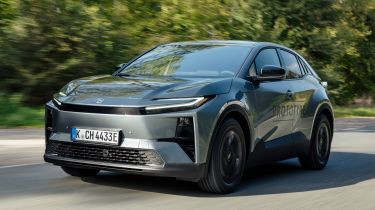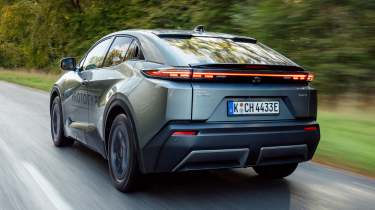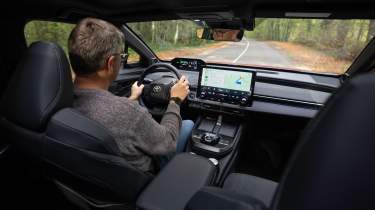New Toyota C-HR+ 2025 review: electric SUV struggles for space
The new Toyota CH-R+ has plenty of plus points, but ultimately fails to stand out from the crowded family EV class

Verdict
While the Toyota C-HR+ might lack a stand-out reason to put it top of the class, it offers a tidy driving experience, has a very strong range figure, decent interior quality and looks smart enough without grabbing attention too much. It’s not the cheapest in the class and neither rear space and comfort or interior stowage are impressive, but it’s a very solid and sensible choice.
The £37,000 point at the top of the Government’s Electric Car Grant has become something of a hotbed of talented electric in the past year or so, and Toyota is the latest to jump into the arena. The likes of the Skoda Elroq – our 2025 Car of the Year – and the Kia EV4 are new to a segment that already boasted established rivals such as the Ford Explorer, Volkswagen ID.4 and Renault Scenic among plenty of others.
Despite the name, the C-HR+ doesn’t share much with the regular hybrid or PHEV Toyota C-HR that’s been on sale for a couple of years in its second-generation form, only the regular parts-bin stuff that goes across brands such as switchgear. It’s a different platform, using the e-TNGA architecture shared with the larger bZ4X and Lexus RZ EVs. The C-HR+ also has a sister car in Subaru’s Uncharted, but unlike its partner, Toyota isn’t bringing in the all-wheel-drive high-powered 338bhp dual-motor car, at least not in the foreseeable future.
Used - available now

2023 Jaguar
I-PACE
29,069 milesAutomaticElectric
Cash £21,781
2022 MINI
3-Door Hatch
21,992 milesManualPetrol1.5L
Cash £17,366
2022 MINI
3-Door Hatch
28,404 milesManualPetrol1.5L
Cash £14,378
2021 MINI
3-Door Hatch
52,506 milesManualPetrol2.0L
Cash £13,971What we do get is 165hp or 221hp front-drive alternatives, the former only available in entry trim and the more potent model likely to be the bigger seller, because it gets a 74kWh battery rather than the 54kWh version. That bumps the range up to a very impressive official figure of up to 378 miles on a charge, outpointing all its core rivals. The smaller battery has a still-decent 283 miles.
The C-HR+ manages to be understated and stylish in an inoffensive way. Some of the lines and creases around the rear end are a little reminiscent of Peugeot’s edgier E-3008, while the front is very close to the larger bZ4X - Toyota’s first production electric car. The bZ is only 170mm longer than its newer sibling, although as could be expected, both rear and boot space are notably better in the larger car. Range and efficiency are significantly worse though, thanks to advances made in optimising systems, as well as aerodynamics that the car’s engineers claim are best in class.
Toyota has tuned the C-HR+ for European roads, and along with attempts to get the centre of gravity as low as possible, it’s proved pretty successful. Obviously a 1900kg SUV is never going to be a sports car, but the chassis in particular feels more nimble than might be expected, and controls body roll well while not proving too firm and crashing over bumps. There is the caveat that the UK’s particular blend of rutted roads could throw up challenges that the smoother French surfaces we drove failed to unmask, but among the electric family SUV set, it can definitely more than hold its own. Traction can be an issue; on our test drive, we found any sort of enthusiastic driving on well maintained dry roads had a habit of waking the yellow-flashing traction control light. It would be interesting to see what it does when roads are damp.
But the surge of power delivery is good, when you haven’t upset the traction control, and the C-HR+ has four levels of brake energy regeneration to further aid the impressive efficiency, with the top setting not quite bringing the car to a halt for full one-pedal driving. They’re controlled via the paddles behind the steering wheel, which as well as feeling cheaper than the other main touch points in the cabin, are also confusingly set for the minus paddle increasing regen and the plus paddle decreasing it.
We saw around 3.7 miles per kWh on our briskly driven test route, so well over 4.0 is easily achievable in regular driving, meaning a real-world range of more than 300 miles.
Our drive, which weaved in and out of small villages outside Paris, did throw up the perennial new-car issue of interminable beeping. Every change of speed limit comes with multiple beeps, and it’s regularly joined by other irritating chirps. A dive into the menus turns them off, but other cars are both less intrusive and relentless, and easier to disable to save your sanity if you’re not a fan.
The 14-inch central touchscreen is, much to our delight, supplemented by rotary dials for the climate control, and buttons for front and rear demist. Take note Chinese brands in particular, where everything runs through the touchscreen. The bad news on the overall visibility score is that there’s no rear wiper, another frustrating modern trend. Doubly so when rear visibility through the narrow sloping screen and around the chunky rear pillars isn’t great.
Cabin quality is good, although we’ll reserve final judgement to when we see the production models. As you'll have spotted from the decals, we were given access to very late-stage development cars, complete apart from some interior finishes. And not slathering the word Prototype across the side. But the quality and variety of materials is good, especially at the upper levels of the cabin, although the small door pockets are cheaper hard plastic. The best of the stowage is the deep central area under the armrest and a tray with a USB-C port beneath the so-called digital island that houses the gear selector and a pair of wireless charging pads. Oddly, there’s no glovebox at all.
Rear passengers aren't as well treated here as they would be in a Skoda Elroq or even a Jaecoo E5, for example. There’s just about enough head and legroom for an adult, although it’s not generous, but the biggest problem is the high floor, created by the battery packaging. Anyone of average adult height will find their knees feel unnaturally high, and the back of your legs is well off the seat cushion. There’s also only a cup-holder-sized rear door bin, although at least rear passengers get a USB-C socket each. The rear doors don’t open particularly wide, which will make fitting a bulky car seat more awkward than it could be.
Boot space of 416 litres is a way off the Skoda Elroq’s 470 litres, and a little behind the Kia EV4. The two hard boot panels drop down to liberate more space, or if you leave them higher there’s somewhere to stow the charging cable under the floor, as well as a flatter boot floor when you drop the rear seats.
Prices will be announced in the latter part of 2025, but expect the C-HR+, which is likely to follow the Icon, Design and Excel trim levels of the hybrid C-HR, to kick off from around £34,000. That will rise to around £37,000 for the mid-spec version and into the low £40,000 area for the top trim. The mid grade should include privacy glass and a powered tailgate, as well as the larger battery, while top-spec cars will have contrasting black roof, 360-degree camera, powered artificial-leather seats and 20-inch alloys compared with the 18-inch rims on the rest of the range.
Did you know you can sell your car through Auto Express? We’ll help you get a great price and find a great deal on a new car, too.
| Model: | Toyota C-HR+ Design |
| Price: | £37,000 (est.) |
| Powertrain: | 72kWh battery, 1x e motor |
| Power/torque: | 221bhp/269Nm |
| Transmission: | Single-speed automatic, front-wheel drive |
| 0-62mph: | 7.3 seconds |
| Top speed: | 99mph |
| Range: | 378 miles |
| Max. charging: | 150kW (10-80% in 28 minutes) |
| Size (L/W/H): | 4,520/1,870/1,595mm |
| On sale: | March 2026 |



